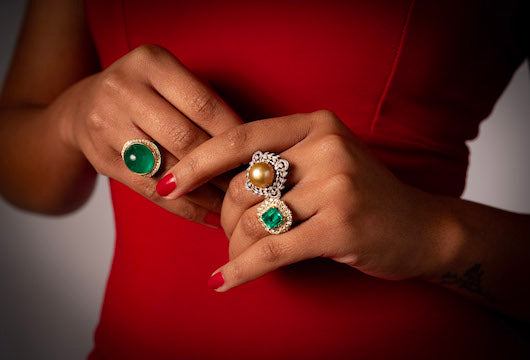Spot the Diamond Imposter
Buying a diamond is an expensive purchase, but sometimes online deals, estate buys, and secondary market items can be tempting (and can help leverage your budget if you know what you are looking for). But how can you tell if a diamond is real? There are many diamonds imposters on the market that can easily be mistaken for the real thing, ranging from natural gems like colorless sapphire, to lab created gems, to CZ and moissanite – it is important to note that this article is geared specifically toward synthetic replicas.
The most recommended and accurate way to determine whether or not a diamond is real is to submit it to a trusted certified jeweler and/or a reputable gemological laboratory for testing – but these methods are not always practical or available when an opportunity to buy arises. The five simple tests below can help you determine if a diamond is real or fake – but you should always have your opinion verified by a graduate gemologist before making a large purchase.
1. Can you Read Letters Through the Stone?
If the stone is loose (not set in a ring or other mounting) and is a traditional round brilliant cut, place it top side down over a piece of paper with writing on its surface. If you can read the writing, the diamond is not real. The refractive index of a diamond is such that clearly reading lettering through its surface would be impossible.
2. Is the Stone Glued into its Setting?
If the diamond is already mounted into a ring or other piece of jewelry, inspect the sides and back of the piece carefully for visible glue remnants (you will probably need to use a loupe to do this). Diamonds are too valuable to be mounted with glue, but rhinestones and synthetics frequently are set in this manner to save on labor costs. Note: Before you perform this test, be sure the piece has been thoroughly cleaned and steamed. Residue on dirty jewelry can be mistaken for glue under magnification.

The settings of this rhinestone piece are closed to allow for foil placement on the backs of the stones.
3. Is the Back of the Setting Open or Closed?
While closed back settings are sometimes seen in antique jewelry pieces, the backs of most diamond jewelry will be open to allow light to pass through the stone. If the back is closed, beware. Rhinestones are frequently set with closed backs to protect the foil backing on the glass that simulates diamond’s sparkle. While pieces like this are sometimes the real thing, it is critical to have closed back jewelry evaluated by an experienced estate jewelry dealer to be certain that the ring or other piece of jewelry you are buying is in fact a beautiful old European cut and not foil-backed paste.
4. How many Facets Can you See on the Top of the Stone?
Genuine diamonds will typically have thirty-three facets on the top portion of the stone, whereas cheap imposters will have far less. The reason is simple – faceting takes time, and less expensive materials simply are not worth the significant amount of effort required to get those proportions correct. While single cut diamonds are not uncommon, they are typically smaller melee stones and will have open backs as opposed to closed (see above).

Look carefully - the facets on these diamond imposters show clear signs of chipping. and half the number of expected facets.
5. Are the Facets of the Stone Crisp and Sharp, or Do They Show Evidence of Chipping or Scratches?
Imposters typically lack the hardness that diamonds possess, and careful inspection will frequently reveal small nicks and scratches from wear that would not be present on a genuine stone. For the same reason, softer stone dupes will frequently have rounded, smooth facets instead of the crisp sharp junctions found on real diamonds.
While these methods are far from a fail-safe way to evaluate fine jewelry, they can help raise red flags that might otherwise be overlooked. If any of these methods raise questions about the jewelry you are buying, take the piece to a graduate gemologist for careful professional evaluation before making your purchase.


